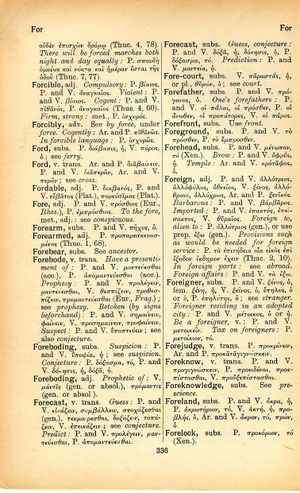fore: Difference between revisions
From LSJ
πῶς δ' οὐκ ἀρίστη; τίς δ' ἐναντιώσεται; τί χρὴ γενέσθαι τὴν ὑπερβεβλημένην γυναῖκα; (Euripides' Alcestis 152-54) → How is she not noblest? Who will deny it? What must a woman have become to surpass her?
(CSV4) |
(6_6) |
||
| Line 3: | Line 3: | ||
P. and V. [[πρόσθιος]] (Eur., ''Rhes.''), P. [[ἐμπρόσθιος]]. | P. and V. [[πρόσθιος]] (Eur., ''Rhes.''), P. [[ἐμπρόσθιος]]. | ||
<b class="b2">To the fore</b>, met., adj.: see [[conspicuous]]. | <b class="b2">To the fore</b>, met., adj.: see [[conspicuous]]. | ||
}} | |||
{{Lewis | |||
|lshtext=<b>fŏre</b>:<br /><b>I</b> inf., [[irregular]], from the [[obsolete]] fuo, and equivalent to futurum esse; and fŏrem, fores, foret, forent, subj. imperf., equivalent to essem, esses, etc., v. [[sum]] init. | |||
}} | }} | ||
Revision as of 08:31, 13 August 2017
English > Greek (Woodhouse)
adj.
P. and V. πρόσθιος (Eur., Rhes.), P. ἐμπρόσθιος. To the fore, met., adj.: see conspicuous.
Latin > English (Lewis & Short)
fŏre:
I inf., irregular, from the obsolete fuo, and equivalent to futurum esse; and fŏrem, fores, foret, forent, subj. imperf., equivalent to essem, esses, etc., v. sum init.

